


March 3, 2019
PHILIP T.D. COOPER
–––––––––––––––––––––––––––
The Surviving Organs of David Tannenberg

March 3, 2019
PHILIP T.D. COOPER
–––––––––––––––––––––––––––
The Surviving Organs of David Tannenberg

The 1787 David Tannenberg organ at the Moravian Church in Lititz, Pennsylvania.
The 1787 David Tannenberg organ at the Moravian Church in Lititz, Pennsylvania.
Throughout his career, David Tannenberg was well-regarded as an organ builder and was in high demand throughout the German-speaking communities to provide organs for their churches. His instruments were the largest and most complete in all of America at the time, and by 1830, many Moravian, Lutheran, and German Reformed churches housed organs made by Tannenberg or one of the other Pennsylvania-German organ builders. This resulted in the first German organ culture unique in the New World. Today, Tannenberg is widely regarded as one of America's greatest organ builders, and indeed, his work could be considered to be comparable to some of the greatest organ builders of that time in Europe. Although only nine of his organs survive today, his special lieblich style has survived in these instruments for us to enjoy. Today, eight of these nine organs either remained in or were restored to their original condition, and the remaining instrument in York has been partially restored, and will be completed in the next few years.
Why are Tannenberg’s organs so unique? While the chronicle of the organ building influences on Tannenberg is far from complete, we do know that he studied organ building in Bethlehem and Nazareth, Pennsylvania under Johann Gottlob Clemm. Clemm was born near Dresden in 1690 and trained there as an organ builder, but with whom is an important question that warrants further research. Together, he and Tannenberg built at least five organs for Moravian chapels. Unfortunately, none of these organs have survived.
After Clemm died on May 5, 1762, there was almost immediately some question as to whether Tannenberg would continue in the organ building business. The Moravian elders were against it, as organ building was connected to a certain level of "worldly disorder", as they put it. It is interesting to note that during this time, Tannenberg ordered a treatise on pipe scaling and tuning from a German organist and theorist, Georg Andreas Sorge. It must be understood that Sorge's work, Die geheime gehaltene Kunst der Mensuration der Orgel-Pfeiffen ("The Secretly Kept Art of Scaling Organ Pipes"), deals, as the title suggests, chiefly with the scaling of pipes but also with tuning. It does not, however, deal with the actual construction of the organ itself.
Sorge's ideas were quite revolutionary, even in late eighteenth-century Germany. His strong support of the use of equal temperament (as opposed to well- tempered systems) was forward-looking indeed. Also, he regularly halved the pipes on the seventeenth note (every seventeenth note is 1/2 the circumference), pointing to developments in organ building in the early nineteenth century. As a result, Tannenberg's organ building style is a mixture of the old-fashioned traditions from Clemm and more modern thinking from Sorge.
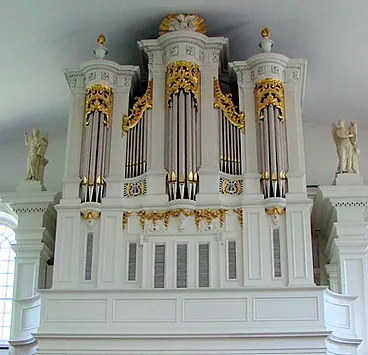
Tannenberg may have also been influenced by the organs built in Philadelphia by Philipp Feyring. He would have had numerous opportunities to see and examine Feyring’s organs during his many trips to the city. Unfortunately, only a portion of a case front survives from Feyring’s work but the resemblance to Tannenberg’s five-sectional cases is remarkable.

Throughout his career, Tannenberg constructed two types of organs: those for the Moravian churches or chapels and those for the Lutheran and German Reformed churches. The organs for the former contained a greater selection of 8' stops, no mixtures, and rarely any reed stops. The organs for the latter were designed with a complete plenum (with mutations) so that even an organ of only eight stops would contain principals from 8’ through a mixture.
The following is a list of the nine surviving organs by Tannenberg complete with historical chronologies, stop lists and various information including pitch, temperaments and wind pressures.

1770 — Zion Lutheran Church in Moselem Springs, Pennsylvania
The organ Tannenberg built for Zion Lutheran Church was one of Tannenberg's earliest, and is quite possibly his opus 8. It is interesting that this is not only the oldest surviving Tannenberg organ, but also the oldest surviving organ built in the Colonies. Tannenberg provided a case of black walnut, the only extant Tannenberg case made from this wood. The organ was dedicated by the pastor, John Helfrich Schaum in fall 1770, and was located in the west gallery of the church's 1761 stone building.
The organ remained in the old church for 124 years. In 1894, the old church was torn down and the present brick building was erected. At this time, the Tannenberg organ was extensively rebuilt by Samuel Bohler of Reading, who replaced the Terz and Mixtur with string stops. He also completely rebuilt the key and stop actions, and, in the process, the old recessed keydesk with a typical late nineteenth century design. The entire winding system was discarded in favor of a single rise bellows installed within the case. Finally, the case was grain-painted a dark brown. When the organ was installed in the new church, only the chest, the case, parts of the stop action, and six ranks of pipes remained from 1770.

After becoming unplayable in the 1950s, the organ was again reworked in 1974. Bohler’s pipe work was removed and modern, factory-made ranks were installed to replace the missing Terz and Mixtur stops. A recessed console was fabricated, and the case was painted an off-white. All other alterations by Bohler, however, were left in place, including the nineteenth century winding system.
In 2010–2011, the organ was completely restored by the shop of R.J. Brunner & Co. All the missing Tannenberg parts were replicated to match the originals, including the eighteenth-century style winding system. The shop of Paul Fritts & Co. in Tacoma, Washington provided the missing Terz and Mixtur, made to match the original Tannenberg pipes. In addition, the case was restored to once again reveal the beautiful black walnut.
In September of 2011, after a little more than a year, the organ was returned to the church. The service of rededication and recital took place on Sunday October 2, 2011 with the author as recitalist. The disposition is as follows:
Principal 8' (lowest nine pipes of stopped wood, the next three of open wood, and the next 25, from tenor C, in the façade)
Flaut Major 8' (open wood pipes)
Principal Octav 4' (two pipes of open wood, and the next ten pipes from low D in the façade)
Flaut Minor 4' (open wood pipes)
Quinte 3'
Sub Octav 2'
Terz 1 3/5'
Mixtur (1 1/2' and 1' to middle C, breaking back to 4' and 3')
Manual compass: C–d3, 51 notes
Pitch: A=458.2 Hz
Temperament: Sorge, 1756 (modified)
Wind pressure: 57.15 mm
Here are two recordings, the first demonstrating the full plenum:
Johann Pachelbel: Magnificat sexti toni, performed by Philip T.D. Cooper.
And now the Principal 8':
Johann Pachelbel: Ach Gott, vom Himmel sieh darein, performed by Philip T.D. Cooper.
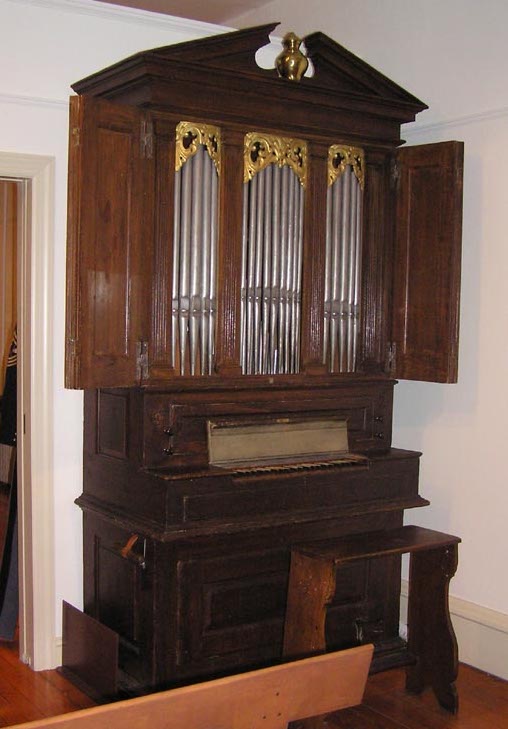
1776 — Moravian Chapel in Bethlehem, Pennsylvania
This organ was originally built by Tannenberg for the Moravian chapel of the Saal or Single Brothers' House in Bethlehem and was dedicated there in November 1776. The cost of the organ was £60. In the 1920s it was removed from Bethlehem and installed in the Whitefield House in Nazareth. The organ is entirely original except for the grain-painting of the case done sometime in the 1830s. In 1997, R. J. Brunner & Co. carried out a complete restoration. The exceptionally beautiful grain-painting of the case was left in place, however.

There are no labels for the stops on this organ, so the following nomenclature is based on Tannenberg's spellings of these stops:
Flaut Amabile 8' (open wood)
Viola de Gamba 8' (stopped wood bass)
Flöt duo 4' (stopped wood C to tenor E, the rest open)
Principal 2' (partially in façade)
Manual compass: C–3', 51 notes
Pitch: A=430 Hz
Temperament: Equal
Wind pressure: 45 mm
Here is a recording featuring the Viola de Gamba 8':
Johann Gottfried Walther: Warum sollt ich mich denn grämen, performed by Philip T.D. Cooper.
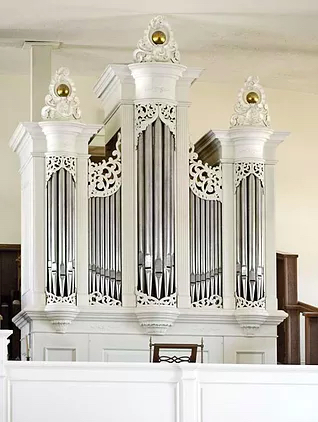
1787 — Moravian Church in Lititz, Pennsylvania
Tannenberg completed the building of an organ for Lititz Moravian Church — his own church — in the summer of 1787. The cost was £200 and it was dedicated along with the new church building on August 13. The organ was placed in the west gallery with the two wedge-shaped bellows in the attic above. These were pumped by pulling on two ropes which hung from the ceiling.

The Tannenberg organ remained in the west gallery for 92 years. In 1879, it was loaned to the Moravian congregation in South Bethlehem. In addition to being moved, it was rebuilt by an unknown builder. A more modern wind system was provided and placed within the case (the two original bellows had been left in the attic in Lititz). Additionally, the entire organ was raised to modern pitch by cutting off the tops of the pipes.
In 1910, the organ was returned to Lititz but was placed in storage in the Single Brothers' House, as well as in the attic of the church. A fire that burned the church in 1957 destroyed those parts stored there as well as the two original bellows that had never been moved from their original location.
From 1980 to 1983, the organ building firm of James R. McFarland & Co. completely restored the organ to its 1787 condition. All the missing parts of the organ were meticulously replicated including the two wedge-shaped bellows, the pedal chest, various parts of the case and the front pipes, all of which had apparently been stored in the church attic. Every effort was made to strictly adhere to Tannenberg's construction methods.
The restored organ was installed in the newly constructed gallery in the Fellowship Hall next to the church. The reconstructed bellows were placed in the attic above the gallery and are pumped by pulling two ropes that hang from the ceiling. This is now the only extant example of this wind system arrangement that was once quite common in many Pennsylvania-German organs.
Additional work and the setting of a new temperament (from Sorge, 1744) was completed by James R. McFarland and Hans Herr in April of 2010.
Manual
Principal 8' (from tenor G, partially in façade)
Flaut Amabile 8' (open wood)
Viol de Gambe 8'
Qünt: Dehn 8' (capped metal)
Principal 4' (partially in façade)
Floth 4' (open wood)
Sub Octav 2'
Pedal
Sub: Bass 16' (stopped wood)
Octav Bass 8' (open wood)
Coppel Pedal
Manual compass: C–e3, 53 notes
Pedal compass: C–g, 20 notes
Pitch: A=440 Hz
Temperament: Sorge, 1744
Wind pressure: 48mm
Here is a recording featuring the Principal 8' and Principal 4':
Johann Christoph Bach: Aus meines Herzens Grunde, performed by Philip T.D. Cooper.
And now the Principal 4' alone:
Valentin Rathgeber: Schlag-Arie 19 in G Major, performed by Philip T.D. Cooper.
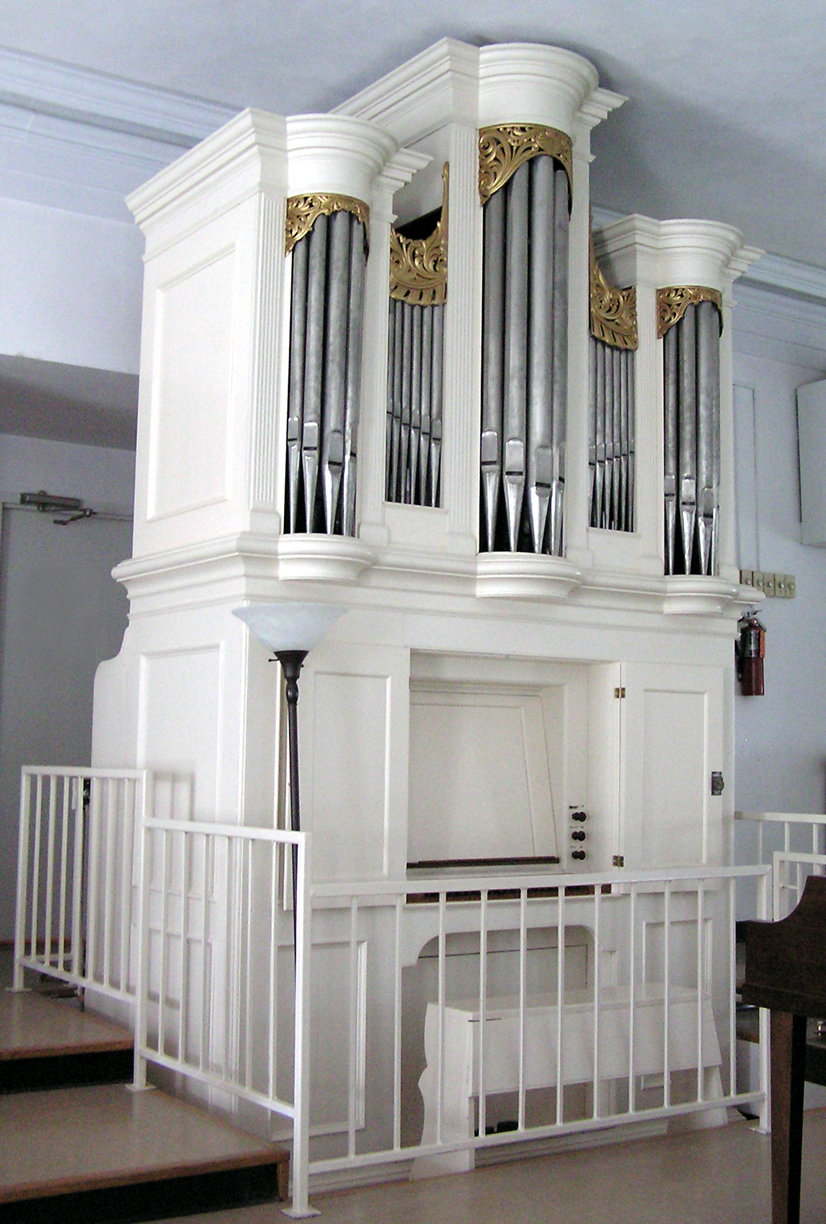
1791 — Zion Lutheran Church in Spring City, Pennsylvania
Tannenberg's organ for Zion Lutheran Church near Spring City was reported to be the first organ in Chester County. For this reason, the church was frequently known as Die Orgelkirche ("The Organ Church"). The organ cost £150 and was originally installed in the church building of 1775, and was consecrated on October 9, 1791. The wind is supplied by a single double-fold wedge bellows installed in the case. The organ was moved by Samuel Bohler to the new church building constructed in 1861. In July of 1881, the organ was then moved from the gallery to the front of the church by J. W. Custer of Pottstown. Custer also removed the top twenty pipes of the Quinte 3', and moved the pipes up on the windchest to create a new Principal 8'. Interestingly, he provided a Pennsylvania- German style open wood bass for the lower twelve pipes. It was probably at this time that a reed organ keyboard replaced Tannenberg's original reversed-color keyboard and the case was painted a dark brown. In the 1970s the church interior was drastically reworked, and the Tannenberg organ was relocated to the back gallery and the case repainted white.

The organ remained in this condition until a thorough restoration by Patrick J. Murphy and Co. in 1998. The Quinte 3' was restored with replica pipes made by Taylor and Boody Organ Builders, and a replica keyboard was furnished by R. J. Brunner and Co. As a result of this restoration, Tannenberg's organ once again speaks as it did in 1791. The only exception is that the organ was pitched at A=440, whereas it was originally almost one half tone higher.
Principal dulcis 8'
Gedackt 8' (stopped wood)
Principal 4' (27 pipes in façade)
Flaute 4' (open wood)
Quinte 3'
Sub Octav 2'
Manual compass: C–f3, 54 notes
Pitch: A=440 Hz
Temperament: Equal
Wind pressure: 51mm
Here is a recording featuring the Gedackt 8' and Flaute 4':
Johann Gottfried Walther: Meinen Jesum laß ich nicht, performed by Philip T.D. Cooper.
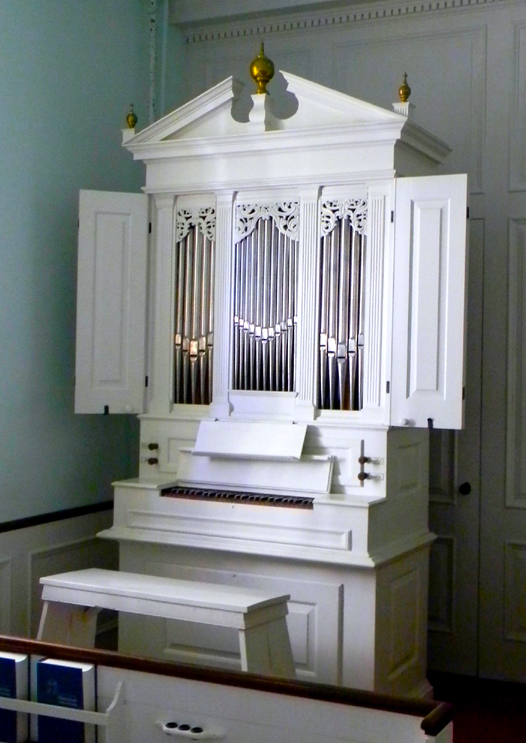
1793 — Moravian Church in Lititz, Pennsylvania
The smaller of the two Tannenberg organs now located at Lititz Moravian Church was originally constructed for the Moravian Chapel in Graceham, Maryland. Tannenberg arrived there with the organ on April 25, 1793, and it was played for the first time on May 4. The cost of the organ was £65 to £70. The organ was used continuously until 1957 when it was sold for $3,000 to the Lititz Moravian Church and set up in the Single Brothers' House. The organ is completely original, and was reconditioned by James R. McFarland in 1984. Additional restoration work was done in 2011 by Ray Brunner and Hans Herr. As part of this work, the walnut stop knobs were stripped of paint and stop labels were added using Tannenberg's spellings found on the stop trundels:

Gedact 8'
Viola da Gambe 8'
Flöth 4'
Principal 2'
Manual compass: C–f3, 54 notes
Pitch: A=394 Hz
Temperament: Equal
Wind pressure: 45mm
Here is a recording featuring the Gedact 8' and Flöth 4':
Johann Pachelbel: Wenn mein Stündlein vorhanden ist, performed by Philip T.D. Cooper.
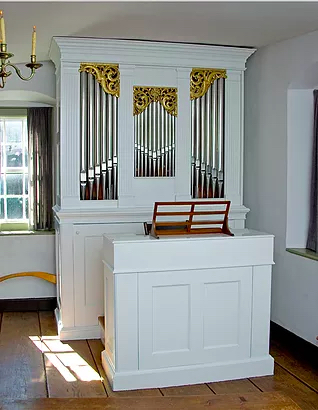
1798 — Single Brothers' House in Old Salem, North Carolina
Tannenberg signed a contract for a new organ for the Salem congregation in 1794 but it was not constructed until 1798. Early in the spring, the organ was delivered and installed by Tannenberg's assistant and son-in-law Philip Bachmann. The cost was £150. It was played for the first time on May 22, 1798. The organ was moved at least once before being dismantled and placed in storage in 1864. It remained there for 100 years, during which time many of the pipes were used in the rebuilding of the larger 1800 Tannenberg. In 1964, the organ was set up in the Single Brothers' House by Charles McManis. Since the original stop list was not known at that time and most of the Viola da Gamba and Quinta Dena were missing, McManis deduced that the other stops were a Quinte 3' and a Terz 1 3/5'. Recently, the diary of Frederic William Marshall has come to light in which he recorded the stop list of this organ as well as the larger 1800 Tannenberg. The organ of five stops has no 2', which is somewhat unusual for an organ from the eighteenth century.

The organ was restored by Taylor and Boody in the summer of 2007. As part of this work, the original pipes were restored and put back in their original places on the original windchest. The case was also restored and painted in its original white. The historical wind system, however, was not reconstructed due to the lack of space.
Gross Gedact 8'
Viola di Gamba 8'
Quinta Dena 8'
Principal 4'
Flauta 4'
Manual compass: C–f3, 54 notes
Pitch: A=412 Hz
Temperament: Equal
Wind pressure: 63.5mm
Here is a recording featuring the Quinta Dena 8':
Improvisation by Philip T.D. Cooper.
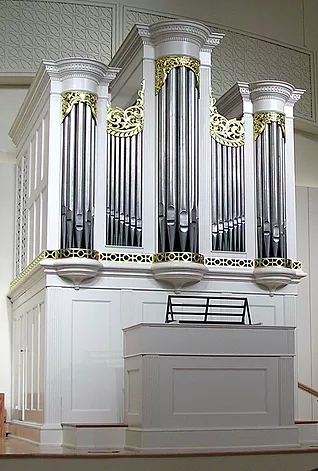
1800 — Home Moravian Church in Old Salem, North Carolina
When the Moravians in Salem were building their new church, they contracted Tannenberg to provide a two manual organ. Much of the instrument was built in Lititz, but parts of the case seem to have been made in Salem. Since Tannenberg, who was 72 at the time, could not make the long journey to Salem, the job of installation was given to Philip Bachmann. Tannenberg received £400 for the organ although the total cost was over £794, which included lodging for Bachmann and the transport of the organ from Lititz.

In 1845, the organ was repaired and tuned by George J. Corrie of Philadelphia. This was probably also the point when a nagshead swell was added to the organ. In 1870, however, the organ was extensively rebuilt by William Schwarze, the southern representative for Henry Erben. He added two ranks of pipes, partly reusing some old pipes from the 1798 Tannenberg which was then in storage, raised the organ's pitch, and revoiced much of the pipework. Additionally, the keyboards and stop knobs were replaced and the case was grain painted. Later, the front pipes were painted in red and yellow stenciling.
In the early part of the twentieth century, the organ was repaired by S. E. Petersen, although the work was apparently not satisfactory as in 1910, and the organ was removed and placed in storage.
However, the three bellows and framework were left in the attic of Home Moravian Church. In the 1960s, the front pipes were flattened, supposedly by a group of boy scouts who had gained access to where the organ was stored.
In 1998, the organ was removed and set up as a temporary display as part of a preliminary study before the actual restoration work could begin. This work was done by the Taylor and Boody shop in Staunton, Virginia. In 2003–2004, the organ was thoroughly restored to its 1800 condition by Taylor and Boody and was placed in the newly constructed Visitors' Center at Old Salem.
Hauptmanual
Principal 8' (partially in façade)
Gross Gedackt 8' (stopped wood)
Quinta Dena 8'
Principal Octav 4' (partially in façade)
Flauta 4' (open wood)
Quinte 3'
Sub Octav 2'
Hinterwerk
Flauta Amabile 8' (open wood)
Viola di Gamba 8'
Flauta douce 4' (open wood)
Salicet 4'
Pedal
Sub Bass 16' (stopped wood)
Violon Bass 8' (open wood)
Manual compass: C–f3, 54 notes
Pedal compass: C–c1, 25 notes
Manual Coppel (shove)
Cappel (pedal coupler)
Pitch: A=410 Hz
Temperament: Equal
Wind pressure: 42mm
This recording demonstrates the string stops: first the Viola di Gamba 8', then the Salicet 4' down an octave, then together:
Improvisation by Philip T.D. Cooper.
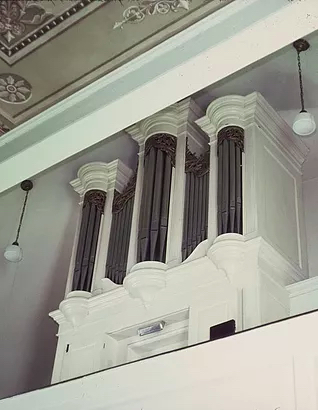
1802 — Hebron Lutheran Church in Madison, Virginia
Tannenberg, who was 74 in 1802, did not travel to Madison to install this organ. In his place, he sent Philip Bachmann. According to the church records, the organ cost £200. With the exception of some nicking to the metal pipes done in the mid-nineteenth century, the organ has remained largely unaltered, and as a result, is the largest and clearest example of the type of organ Tannenberg built for Lutheran and German Reformed churches. In 1970, the organ was reconditioned by George Taylor.

Principal dulcis 8' (quintadena bass; from tenor C, partially in the façade)
Gedackt 8' (stopped wood)
Principal 4' (partially in façade)
Flaute 4' (open wood)
Quinte 3'
Octav 2'
Terzan: 1 3/5' to tenor B, at middle C becomes 3 1/5'
Mixtur (1 1/2' and 1' to tenor B, at middle C becomes 4' and 3')
Manual compass: C–f3, 54 notes
Pitch: A=430 Hz
Temperament: Equal
Wind pressure: 43mm
Here is a recording of the full organ with the unusual Terzan stop:
Johann Krieger: Praeludium in F Major, performed by Philip T.D. Cooper.
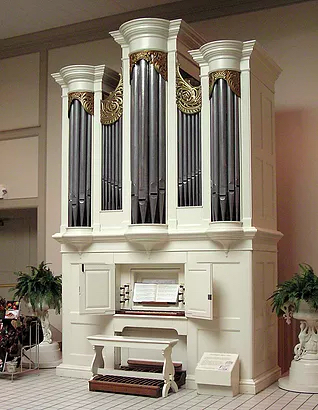
1804 — Christ Lutheran Church in York, Pennsylvania
On April 16, 1804, Tannenberg, who was 76 and in failing health, set out for York to wait for the wagon that had been packed with a newly constructed organ for the Lutheran Church there. This was to be his last organ, a one manual and pedal instrument of 13 ranks in a splendid case, costing £355. On May 17th toward evening, while he was standing on a bench or scaffold to tune, Tannenberg suffered a stroke and fell to the gallery floor, striking his head. He died two days later. The funeral service was held in Christ Lutheran Church on May 21st with his organ playing for the first time.

The organ remained in the Lutheran Church's old stone building of 1762, until that church was torn down and a new one built in 1811–1812. The Tannenberg organ was placed in the west gallery of the new building where it remained until 1874. In that year, the church completely rebuilt the interior of their building, adding a new floor at the level of the galleries. This was a common rearrangement process in Pennsylvania churches done in order to provide more space, including rooms for a Sunday school. A new gallery was installed, but because of the limited height, the case of the organ was shortened. An old photograph shows the organ still in the church's gallery in this state.
The organ builder who performed this work has remained unknown despite extensive research. It is also quite possible that the organ had been worked on at some point by Henry F. Berger, who established an organ building shop in York in 1859. However, it could not have been Berger who altered the organ in 1874 as he had died in Ohio in 1862. However, the keyboard and pedalboard as well as Tannenberg's Trumpete 8' were replaced (with a tenor c Oboe 8') and these bear a strong resemblance to Berger’s extant work.
In 1893, Christ Lutheran Church purchased a new organ and the Tannenberg organ went unused until it was dismantled and completely rebuilt in 1905 by Reubin Midmer & Son. His alterations were extensive: an internal framework was constructed to support the chest instead of by the case itself and the bottom side panels were swung out to the front to support new zinc front pipes. The entire winding system was discarded, and a new single-rise reservoir was placed within the case. In addition, Tannenberg's pedal chest and pedal action were discarded in favor of a tubular-pneumatic chest. Midmer also raised the wind pressure (which was necessary for the tubular-pneumatic action to work properly) and raised the cut-ups on many of the pipes. The rebuilt organ was installed in the Beehive Chapel which was used by the Sunday School of Christ Church.
In 1945, the Tannenberg was removed from the Beehive Chapel and given to the Historical Society of York County (now the York County History Center). It was not until 1958 that the organ was set up in their museum, the work being completed by Fred Furst. E. Power Biggs helped make this organ well-known through his recording The Organ in America, which featured the Tannenberg organ on more than half of the LP record. The sound there was magnificent, as the room, which had been a former car show room, was large and the floor was solid concrete.
In 1986, the Historical Society embarked on an ambitious plan to completely renovate their facilities. As part of this work, the Tannenberg organ was to be relocated to a more prominent location within the museum. The author took over as consultant and after some discussion, the decision was made to contract with R. J. Brunner & Co. to restore the organ to its 1804 condition. In July of 1987, the Tannenberg organ was dismantled and the work of restoration begun. The Brunner shop completely restored the case, returning it to its original height and fabricating new upper side panels. The internal framework from 1905 was removed and the chest was made to once again be supported by the case. All the pipe work was restored as much as possible. However, lack of funds prevented the pedal chest as well as the old wind system from being replicated. Also, the Oboe 8' from 1859 was retained. Since no reed stop from any Pennsylvania-German organ has survived, the replication of a Trumpet for this organ will have to be somewhat of an extrapolation. Plans are now in place to finally return this magnificent work of David Tannenberg to its entirely original state, the work being scheduled for late 2020 and to be carried out by R. J. Brunner & Co.
Manual
Principal 8' (partially in façade)
Groß Gedackt 8' (stopped wood)
Viola da Gamba 8'
Principal Octav 4' (partially in façade)
Flaute 4' (open wood)
Quinte 3'
Sub Octav 2'
Mixtur (2-3 ranks, similar to the Madison organ, except a 1 3/5' joins at tenor F)
Trompete 8'
Pedal
Sub Bass 16' (stopped wood)
Octav Bass 8' (open wood)
Manual compass: C–f3, 54 notes
Pitch: A=450 Hz
Temperament: Equal
Wind pressure: 67mm
To end this listing of the extant organs of David Tannenberg, here is a recording of the plenum of his last instrument:
Johann Ludwig Krebs: Sei lob und Ehr, performed by Philip T.D. Cooper.
––––––––––––––––––––––––
The views and opinions expressed in this article are those of the author, and do not necessarily reflect the position of Vox Humana.